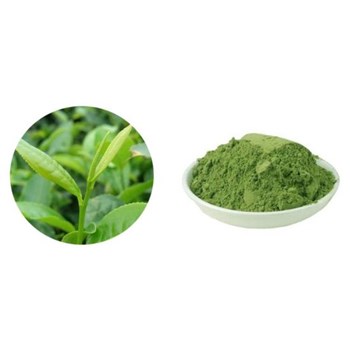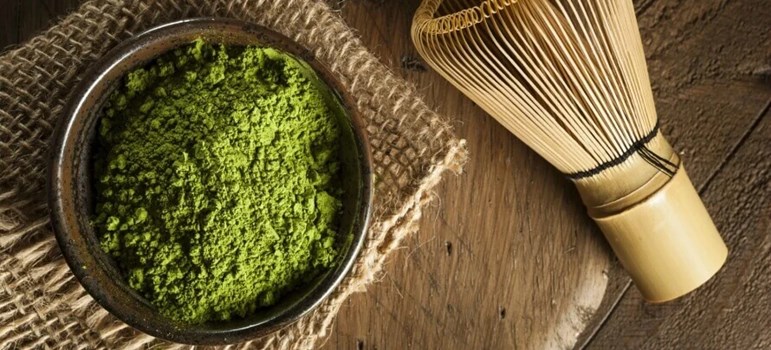Green tea extract is the active ingredient extracted from green tea leaves, mainly including tea polyphenols (catechins), aromatic oils, moisture, minerals, pigments, carbohydrates, proteins, amino acids, vitamins, etc.
Tea polyphenols have the effects of anti-oxidation and scavenging free radicals, significantly reducing the content of serum total cholesterol, triglycerides, and low-density lipoprotein cholesterol in hyperlipidemia, and at the same time have the function of restoring and protecting the function of vascular endothelium. The blood lipid-lowering effect of tea polyphenols is also one of the main reasons why tea can make obese people lose weight without rebounding.
Green Tea Polyphenols (GTP) is the main component of green tea, accounting for about 30% of the dry matter. GTP is extracted from tea and its by-products (tea powder, tea chips, rough tea or pruned leaves). Since it is only extracted with food-grade ethyl acetate, the original structure of GTP is retained, and the product is a light yellow powder. The main component is composed of catechins, accounting for about 60% to 80% of the total GTP, which contains 4% to 6% epicatechin (L-EC), 6% to 8% gallocatechin (DL -EC), 10%~15% epigallocatechin (L-EGC), 50%~60% epigallocatechin gallate (L-ECG), and 8%~10% caffeine.
The GTP structure is rich in phenolic hydroxyl groups, which can provide active hydrogen to inactivate free radicals, and the free radicals formed by oxidation themselves have higher stability due to the catechol structure. Therefore, GTP has the function of scavenging free radicals and inhibiting lipid peroxidation
Health function:
[Hyperlipidemia effect]: Tea polyphenols can significantly reduce the serum total cholesterol, triglycerides, and low-density lipoprotein cholesterol content of hyperlipidemia, and at the same time have the effect of restoring and protecting the function of vascular endothelium. The blood lipid-lowering effect of tea polyphenols is also one of the main reasons why tea can make obese people lose weight without rebounding.
[Antioxidant effect]: Tea polyphenols can block the process of lipid peroxidation and increase the activity of enzymes in the human body, thereby playing an anti-mutation and anti-cancer effect.
[Inhibition of tumor]: Tea polyphenols can inhibit the synthesis of tumor cell DNA and induce mutations in DNA fragmentation, thereby inhibiting the synthesis rate of tumor cells and further inhibiting the growth and proliferation of tumors.
[Bactericidal and detoxification effects]: Tea polyphenols can kill botulinum and spores, and inhibit the activity of bacterial exotoxins. It has antibacterial effect on various pathogenic bacteria that cause diarrhea, respiratory tract and skin infections. Tea polyphenols have obvious inhibitory effects on Staphylococcus aureus and mutans which cause purulent infection, burns and trauma.
[Hanging out and protecting the liver]: Alcoholic liver damage is mainly caused by free radical damage caused by ethanol. As a free radical scavenger, tea polyphenols have the effect of inhibiting alcoholic liver damage.
[Detoxification effect]: Severe environmental pollution has obvious toxic effects on human health. Tea polyphenols have a strong adsorption effect on heavy metals, and can form complexes with heavy metals to produce precipitation, which is beneficial to reduce the toxicity of heavy metals to humans. effect. In addition, tea polyphenols also have the effects of improving liver function and diuresis, so they have a better anti-decomposition effect on alkaloid poisoning.
[Improve the body's immunity]: Tea polyphenols stimulate the change of antibody activity by increasing the total amount of human immunoglobulin and maintaining it at a high level, thereby improving the overall immunity of the human body and promoting the body’s own conditioning function.
Food applications:
As a natural antioxidant, tea polyphenols have been widely used in the food industry. my country’s food additives use standards stipulate that tea polyphenols can be used in foods such as fats, moon cakes, and ham, with a dosage of 0.4g/kg. The method of use is to dissolve it in ethanol, add a certain amount of citric acid to make a solution, and then apply it to food by spraying or adding.
[Meat products]: Meat and its products often turn yellow due to the automatic oxidation of fat during storage, and appear rancid. In the processing of meat products, the tea polyphenol solution prepared by soaking or spraying various meat products can make the protein and tea polyphenols on the surface of the meat products form an airtight hard film, which can inhibit the surface oxidation and rancidity of the meat products. The growth of bacteria and the good effect of preventing spoilage.
[Edible animal and vegetable oils]: Animal oils are easily oxidized and deteriorated because they do not contain natural antioxidants. Adding tea polyphenols to oils can prevent and delay the automatic oxidative decomposition of unsaturated fatty acids, effectively inhibit the oxidative rancidity of oils and extend their storage period.
[Fried food]: During the frying process, the color of fried food becomes darker and black due to oxidation; during storage, as the oxidative rancidity of the oil gradually deepens, the aroma and flavor of the product are seriously affected. Tea polyphenols have a better antioxidant effect on fried foods, which can delay oxidative rancidity and increase the shelf life of foods.
[Baked food]: In the production of moon cakes and other oily foods, adding tea polyphenols to the mixture of flour and oily products can not only solve the anti-corrosion of these foods, but also play a role in nutrition and health care and enhance the flavor of the food.
[Aquatic products]: Tea polyphenols have significant anti-oxidation, anti-corruption and anti-browning effects in the preservation and processing of fish, shrimp and other aquatic products. When making dried fish products, the aquatic products are impregnated with water containing tea polyphenols, which can prevent the dried fish from turning yellow and lipid oxidation due to “oil burning”. When freezing fresh fish, adding tea polyphenol preparations can also make the fish fresher.
[Beverages]: Tea polyphenols can be used to prepare various tea beverages and applied to various alcoholic beverages. It can also inhibit the destruction of vitamin A and vitamin C in beverages such as soy milk, soft drinks, fruit juices, etc., thereby protecting the beverages Of various nutrients.
[Candy food]: Tea polyphenols are used in chewing gum, filling candies, fruit candies and other candies, which can effectively resist oxidation and preserve freshness, fix color and solidify fragrance, and eliminate bad breath. In addition, tea polyphenols can also make the “acid tail” in high-sugar foods disappear, making the taste sweet and refreshing.
Future market conditions:
The extraction of tea polyphenols from tea as raw materials has the most Chinese characteristics and advantages, and it is also the inevitable way out of crude tea, a by-product of tea production. This development of turning waste into treasure makes tea’s health function better for the benefit of mankind. And has considerable economic benefits.
The price of tea polyphenols, which is a natural anti-oxidant preservative for food, is generally 1 to 1.5 million yuan per ton; as a raw material for health care products, its price can reach 1.6 to 2 million yuan per ton. In the next 5 years when synthetic food antioxidants and natural products coexist, the annual demand for tea polyphenols will gradually transition from 500 tons to 5000 tons, and the annual demand will rise to tens of thousands of tons in the future; as a huge added value The main ingredient of health care products, tea polyphenols will gradually increase from tens of tons to hundreds of tons.
Other application editing Voice
As an excellent additive for cosmetics and daily chemicals: it has a strong antibacterial effect and enzyme inhibitory effect. Therefore, it can prevent skin diseases, skin allergies, remove skin pigments, prevent dental caries, dental plaque, periodontitis and bad breath, etc.
Post time: Mar-22-2022

